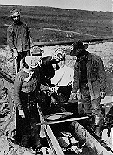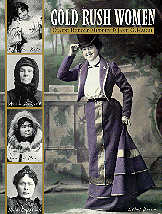|
________________
CM . . . .
Volume V Number 4 . . . . October 16, 1998
excerpt: Women have made their minds up to go to the Klondike, so there is no use trying to discourage them...our wills are strong and unfailing. There are a few things, however, women should carefully consider before starting on this really perilous journey.One in every ten people who went to the Klondike in the 1890s was a woman. In fact, Murphy and Haigh tell us, it was probably a woman who panned the first gold on Rabbit Creek near the Yukon River and started Canada's famous gold rush of 1896. 
The authors' twenty-three biographical sketches examine the lives of women who typify the collective experience of the "fair sex" in gold-rush times. The biographies move historically from the Aboriginal wives, who kept the first white prospectors alive, through women's lives in the gold-fields and the boom-towns of the Klondike, then into the modern era. Women, like men, had to make the long harrowing trek over the Rocky Mountain's Chilicott and White Passes into the Klondike gold fields. They not only faced the same dangers as the men, they endured extra hardships given the time's prejudices against wom en. Some went with their husbands, some went in search of a rich husband, but many went in hope of becoming self-reliant independent prospectors or entrepreneurs. It was a tough time, and the weak, including the women, were not given any added considera tion. Murphy and Haigh tell stories about some good people and some who were not so virtuous; however, all of them sought a golden future. Unfortunately, as the authors also tell, only a few found many riches beyond their adventures. The authors are Alaskan historians, and the book has a natural American orientation. This does not detract from the value Canadian students can derive from its well constructed narrative. Essentially, the women who settled on the Canadian side of the gol d fields did not experience a fundamentally different life from those who settled on the Alaskan side. Indeed, prospectors had to travel through Canada to get to the gold fields, and most lived for a time in the Yukon Territory before moving to newer cla ims. They also moved back and forth between the Yukon and Alaska, searching for the elusive big strike. Consequently, political divisions of territory meant little to these men and women during gold rush years. One chapter specifically examines women's varied roles in the development of Dawson City and Whitehorse in Canada's Yukon Territory. The last biography in this section tells the story of Martha Black, an original pioneer of the North, who became the Yuko n's Member of Parliament in 1935 and the second woman elected to serve in Canada's parliament. The text is complemented by archival photographs of the women whose lives are part of this history. There are dozens of wonderful images of the trek over the mountain passes, the rough and ready gold field encampments and towns bursting with vibrant acti vity. This work offers a wealth of information and insight into a colourful era. Students should enjoy reading this short, accessible book. Highly recommended. Ian Stewart regularly reviews for CM, NeWest Review and the Winnipeg Free Press.
To comment on this title or this review, send mail to cm@umanitoba.ca.
Copyright © the Manitoba Library Association.
Reproduction for personal use is permitted only if this copyright notice
is maintained. Any other reproduction is prohibited without
permission.
Published by
TABLE OF CONTENTS FOR THIS ISSUE - OCTOBER 16, 1998.
AUTHORS |
TITLES |
MEDIA REVIEWS |
PROFILES |
BACK ISSUES |
SEARCH |
CMARCHIVE |
HOME
|

